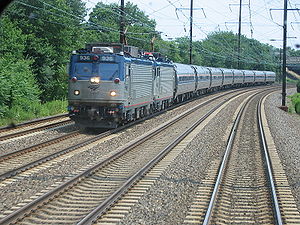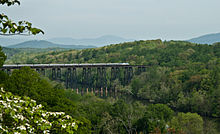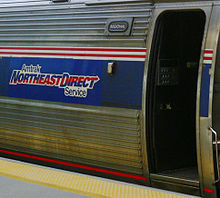- Northeast Regional
-

Northeast Regional
Two AEM-7s lead a Regional through New Jersey in 2005.Overview Service type Regional rail Status Operating Locale Northeastern United States Current operator(s) Amtrak Average ridership 7,148,998 (2010 total)[1] Route Start Boston or Springfield, Massachusetts No. of intermediate stops 35 between Boston and Newport News, 7 on Springfield branch End Newport News or Lynchburg, Virginia Distance travelled 664 mi (1,069 km) Average journey time 12 hours 30 minutes Service frequency 18 trains per day[2] On-board services Seating arrangements Airline-style coach seating Catering facilities On-board café Baggage facilities Checked baggage available at selected stations Technical Gauge 4 ft 8 1⁄2 in (1,435 mm) Operating speed max: 125 mph (201 km/h) Route map Legend


94 mi (151 km) Springfield 


MA/CT border 


109 mi (175 km) Windsor Locks 


114 mi (183 km) Windsor 


120 mi (190 km) Hartford 


131 mi (211 km) Berlin 


138 mi (222 km) Meriden 


144 mi (232 km) Wallingford 


0 mi (0 km) Boston South Station 


1 mi (1.6 km) Boston Back Bay Station 


11 mi (18 km) Rt. 128 


MA/RI border 


43 mi (69 km) Providence 


70 mi (110 km) Kingston 


87 mi (140 km) Westerly 


RI/CT border 


96 mi (154 km) Mystic 


105 mi (169 km) New London 


123 mi (198 km) Old Saybrook 





156 mi (251 km) New Haven 


173 mi (278 km) Bridgeport 


195 mi (314 km) Stamford 


CT/NY border 


212 mi (341 km) New Rochelle 


231 mi (372 km) New York Penn Station 


NY/NJ border 


241 mi (388 km) Newark Penn Station 


244 mi (393 km) Newark Airport 


255 mi (410 km) Metropark 


263 mi (423 km) New Brunswick 


279 mi (449 km) Princeton Junction 


289 mi (465 km) Trenton 


NJ/PA border 


305 mi (491 km) Cornwells Heights 


318 mi (512 km) North Philadelphia 


322 mi (518 km) Philadelphia 


PA/DE border 


347 mi (558 km) Wilmington 


359 mi (578 km) Newark 


DE/MD border 


386 mi (621 km) Aberdeen 


416 mi (669 km) Baltimore 


427 mi (687 km) BWI Airport 


448 mi (721 km) New Carrollton 


MD/DC border 


457 mi (735 km) Washington D.C. 


DC/VA border 


465 mi (748 km) Alexandria 





481 mi (774 km) Woodbridge 


491 mi (790 km) Quantico 


511 mi (822 km) Fredericksburg 


555 mi (893 km) Ashland 


566 mi (911 km) Richmond Staples Mill Road 


573 mi (922 km) Richmond Main Street 


621 mi (999 km) Williamsburg 


644 mi (1,036 km) Newport News 


Burke Centre 


490 mi (790 km) Manassas 


525 mi (845 km) Culpeper 


569 mi (916 km) Charlottesville 


630 mi (1,010 km) Lynchburg The Northeast Regional is an intercity rail service operated by Amtrak in the Northeastern United States. In the past, it has also been known as the NortheastDirect, Acela Regional, and Regional. It is by far the busiest Amtrak route, carrying 7.15 million passengers in fiscal year 2010.[1] The second-busiest Amtrak service is the Acela Express which carried around 3.2 million passengers the same year.[1] The Northeast Regional had a total revenue of $458,105,798 in fiscal year 2010, up from $431,430,679 in 2009.[1]
There is frequent daily all-reserved service, operating every hour of every day. Trains generally operate between Boston, Massachusetts, and Washington, D.C., with extra service between New York City and Washington and some extended service to Springfield, Massachusetts, Richmond, Virginia, Newport News and Lynchburg, Virginia.
Travel times are approximately 4.5 hours between Newport News and Washington, two hours between Washington and Philadelphia, 1.5 hours between Philadelphia and New York, 3.5 hours between New York and Springfield, and four hours between New York and Boston.
Contents
Equipment
Trains are usually 6 to 10 cars long, with a single locomotive pulling at the head end. Today's Northeast Regional uses equipment that is roughly equivalent to the last iteration of the defunct Metroliner service, which had used the same AEM-7 electric locomotives at speeds up to 125 MPH, and used Amfleet II passenger cars. Many Northeast Regional trains have their southern terminus at Washington D.C. However, the number of daily NE Corridor trains that extend into Virginia is increasing annually, according to Amtrak Virginia.
Today, the passenger cars are rebuilt Amfleet I series passenger cars built by the Budd Company in the mid to late 1970s. Prior to March 2008, when Amtrak changed its format for the new Northeast Regional service, the first car was Business Class (formerly the last car), and the second car was the operational Café Car (formerly the second-to-last car). Today, all regional trains have the cafe in the middle of the train, but the business class car is still on the front. If a second Café Car is present, it is only used for passenger seating. Some trains offer a limited number business class seating at the front of the Café Car, instead of having a dedicated Business Class car. The Coach Class car adjacent to business class usually is designated the quiet car, where passengers are asked to refrain from loud talking and mobile phone conversations. In extremely rare occasions, an ex-Metroliner cab car used for the Keystone Service and the New Haven–Springfield Shuttle will be included at the front (after the locomotive) or end of the train.[3] This is usually a deadheaded car, and the locomotive will be leading anyway as all Amtrak trains on the Northeast Corridor with the exclusion of the Keystone will have the locomotive leading, regardless of the direction.
Between Boston and Washington the service has overhead electric wires and largely travels over Amtrak owned-and-operated tracks. This segment reaches speeds of 125 MPH and uses electric locomotives, including the AEM-7 class, built 1978–1987 for the now retired Metroliner service with 5800 horsepower (5.2 MW), the rebuilt AEM-7AC with 8000 horsepower (6 MW), and the Bombardier/Alstom HHP-8 built 1999–2002, also with 8000 horsepower (6 MW). The 8000 horsepower locomotives are not as commonly used on NE Regional trains, since they are standard power for the long-distance trains that use the Northeast Corridor (the Cardinal, the Carolinian, the Crescent, the Palmetto, the Silver Meteor and the Silver Star).
NorthEast Regional trains in Virginia and along the route between Springfield, MA and New Haven, CT, use GE P42DC diesel locomotives and have generally lower peak train speeds. Because these travel segments are using freight railroad tracks, these trains also are more likely to suffer unexpected delays due to congested tracks.
History
. A Virginian Northeast Regional crosses the James River near Lynchburg in 2011
A Virginian Northeast Regional crosses the James River near Lynchburg in 2011 See also: List of Amtrak routes#Northeast Corridor
See also: List of Amtrak routes#Northeast CorridorThe services along the line, as inherited from Penn Central, once had their own names, like the Yankee Clipper and the Federal; typically a name applied to at most one train and its "twin" in the opposite direction. On October 28, 1995, Amtrak introduced the NortheastDirect brand for all trains on the Northeast Corridor (and its extension to Newport News, Virginia) except for the express Metroliner and hourly Clocker services.[4] The November 10, 1996 timetable restored the old names in addition to the NortheastDirect brand.[5] The names (except the Twilight Shoreliner) were permanently dropped with the May 16, 1999 schedule,[6] and on January 31, 2000 the first rebranded Acela Regional electrified trains ran.[7] Due to confusion with the Acela Express, the name was changed again on March 17, 2003 to Regional.[8] On April 7, 2008 with the release of their new timetable, the name was changed again to Northeast Regional and as a result, Amtrak has started adding the new Northeast Regional logo to their cafe cars.[9][10] However, as of 2010[update], some Amfleet cars still have the NortheastDirect branding in the side.
Virginia service
Although Virginia is not strictly part of the Northeast Corridor, some Northeast Regional trains continue into Virginia, serving Richmond, Newport News, Lynchburg and points in between. Unlike the Northeast Corridor, these tracks are not electrified and are owned by freight railroads. The short distance between Richmond's northern railway station and its downtown Main Street railway station travels at a very slow speed because of the reliance on freight railway track rights through a CSX rail yard. The Commonwealth of Virginia and Amtrak formally partnered in 2009 under the brand Amtrak Virginia to expand passenger rail service within the Commonwealth.
Northeast Regional service south to Alexandria, Richmond, Williamsburg, and Newport News formally began on June 14, 1976, when Amtrak ended the Newport News 'section' of the James Whitcomb Riley. This extension travels over CSX tracks from Washington, DC south to Newport News, VA. The long-standing service to Newport News, which operates 2 trains per day in each direction, has not been subject to either a subsidy or performance guarantee by the Department of Rail & Public Transportation (DRPT), Commonwealth of Virginia.
In October 2009 Amtrak extended the Northeast Regional with daily service from Alexandria, VA, via Burke, Manassas, Culpeper, and Charlottesville, to Lynchburg with support from the Department of Rail & Public Transportation, Commonwealth of Virginia. This extension travels over CSX tracks between Washington, DC and Alexandria, VA, and travel over Norfolk Southern tracks between Alexandria and Lynchburg. In the first month ridership doubled expectations.[11] DRPT provided a performance guarantee for this route.
A further extension south from Richmond, VA to Norfolk, VA along Norfolk Southern tracks is being planned by the Department of Rail & Public Transportation (DRPT), Commonwealth of Virginia in cooperation with Amtrak. Certain track upgrades (e.g. passing sidings, replacing track to increase operating speeds) between Richmond and Norfolk that are necessary to enable this extension are being funded jointly by Norfolk Southern and DRPT. This extension is expected to open in 2013, according to DRPT's official web site.
Classes of service
- Coach class: Regional Coach cars have 2x2 seating with reading lamps, fold-out tray tables, and either at least 1 (120 V, 60 Hz AC) electrical outlet per seat pair. Reservations are required.
- Business Class: This is either a re-purposed Long-Distance Coach car with 2x2 seats, reading lamps, fold-out tray tables, and at least 1 (120 V, 60 Hz) electrical outlet per seat pair, or this is a separate seating area with 1x2 leather seats, with deep recline, reading lamps, fold-out-tray tables, and at least 1 (120 V, 60 Hz) electrical outlet per seat pair located at one end of a combination Cafe/Business Class car. The primary difference between Long-Distance Coach seats Regional Coach seats is additional leg room. Business Class passengers receive complimentary soft drinks. The Business Class car is normally supplied with a daily newspaper, often The New York Times, at its origin station.
- First Class is no longer available on Northeast Regional trains. It is now exclusively on Acela Express trains.
Beginning with the schedule effective April 25, 2005, Amtrak abolished the previously common unreserved trains. Now, any ticketed passenger is guaranteed a seat on his/her train. "Reservations" may be made at any time after eleven months prior to the train's departure, easing the frequent practice of arriving at the station and purchasing a ticket for the next train. Now reservations are made online at amtrak.com or at 1-800-USA-RAIL. Tickets may also be purchased at the station closer to departure if the station is equipped with a ticket window. Quick Trak machines are available for self ticket service in place of a ticket window.
Route
The Northeast Regional operates over Massachusetts Bay Transportation Authority, Amtrak, Metro-North Railroad, and CSX Transportation trackage when trains head to Newport News:
- MBTA Providence/Stoughton Line, Boston to Massachusetts/Rhode Island state line (dispatched and maintained by Amtrak)
- Amtrak New Haven-Springfield Line from Springfield to New Haven
- Amtrak Northeast Corridor, state line to New Haven
- MNRR New Haven Line, New Haven to New Rochelle
- Amtrak Northeast Corridor, New Rochelle to Washington
- Richmond, Fredericksburg and Potomac Railroad, Washington to Alexandria, Virginia, now CSX
- CSX Landover Subdivision, RF&P Subdivision, Richmond Terminal Subdivision, Bellwood Subdivision, and Peninsula Subdivision, Alexandria, Virginia to Newport News
Or, when trains head to Lynchburg, Northeast Regional operates over Massachusetts Bay Transportation Authority, Amtrak, Metro-North Railroad, CSX Transportation, and Norfolk Southern Railway trackage:
- MBTA Providence/Stoughton Line, Boston to Massachusetts/Rhode Island state line (dispatched and maintained by Amtrak)
- Amtrak New Haven-Springfield Line from Springfield to New Haven
- Amtrak Northeast Corridor, state line to New Haven
- MNRR New Haven Line, New Haven to New Rochelle
- Amtrak Northeast Corridor, New Rochelle to Washington
- CSX, Washington to Alexandria, Virginia; formerly Richmond, Fredericksburg and Potomac Railroad
- Norfolk Southern, Alexandria to Lynchburg, Virginia; formerly Southern Railway, and originally Virginia Midland Railway
There is frequent service between Washington-New York and Washington-Boston throughout the day. There is some service to Springfield, Massachusetts, either through to Washington or via a connection at New Haven, Connecticut. Trains between Springfield and New Haven operate over Amtrak trackage but require a diesel locomotive over that portion. Some trains go as far south as Richmond, Newport News, Virginia or Lynchburg, Virginia.
Until around 1999, some service to Springfield continued east to Boston, for an alternate Inland Route between New York and Boston. One weekend train stayed along this route until the November 1, 2004 schedule.
One train, the Federal (Twilight Shoreliner until 2004), used to provide premium overnight sleeper service between Washington and Boston, giving the corridor 24 hour service; the Federal name (briefly resurrected in 2004) is no longer used as an indication of the absence of sleeper service, but a Northeast Regional runs in its place.
Station stops
External links
References
- ^ a b c d "AMTRAK SETS NEW RIDERSHIP RECORD, THANKS PASSENGERS FOR TAKING THE TRAIN". Amtrak. 11 October 2010. http://www.amtrak.com/servlet/BlobServer?blobcol=urldata&blobtable=MungoBlobs&blobkey=id&blobwhere=1249215885709&blobheader=application%2Fpdf&blobheadername1=Content-disposition&blobheadervalue1=attachment;filename=Amtrak_ATK-10-134_Amtrak_Sets_Ridership_&_Revenue_Records_in_FY_2010_(10-11-10).pdf. Retrieved 26 October 2010.
- ^ Northeast Regional schedule
- ^ "RARE MUST SEE!! Late 137 with Amtrak Cabcar!". http://www.youtube.com/watch?v=CRZ1fmv8KYA.
- ^ Matthew Mitchell, Free rides, misc.transport.urban-transit October 27, 1995
- ^ Scanner, Trains February 1997
- ^ A step back in the Northeast, Trains August 1999 page 17
- ^ Ron Newman, Acela Regional starts Jan 31, 2000, misc.transport.rail.americas January 27, 2000
- ^ Rail Travel News – News Posting March 23, 2003
- ^ "Timetable with new service name". http://www.amtrak.com/timetable/apr08/W04.pdf.
- ^ "Cafe car with Northeast Regional logo". http://photos.nerail.org/showpic/?photo=2008092420262831715.jpg&order=bydate&page=3&key=.
- ^ Reed, Ray (December 16, 2009). "Amtrak's Lynchburg-Washington line beats projections". The News & Advance. http://www2.newsadvance.com/lna/news/local/article/amtraks_lynchburg-washington_line_beats_projections/22419/. Retrieved 2009-12-17.
Northeast Corridor services Inter-city Amtrak Acela Express • Northeast Regional • New Haven – Springfield Shuttle • Cardinal • Carolinian • Crescent • Keystone • Palmetto • Pennsylvanian • Silver Meteor • Silver Star • VermonterNJ Transit Commuter MBTA CDOT Metro-North NJ Transit SEPTA Trenton Line • Wilmington/Newark LineMARC Penn LineCategories:- Amtrak routes
- Passenger rail transportation in Massachusetts
- Passenger rail transportation in Rhode Island
- Passenger rail transportation in Connecticut
- Passenger rail transportation in New York
- Passenger rail transportation in New Jersey
- Passenger rail transportation in Pennsylvania
- Passenger rail transportation in Delaware
- Passenger rail transportation in Maryland
- Passenger rail transportation in Washington, D.C.
- Passenger rail transportation in Virginia
- United States regional rail systems
Wikimedia Foundation. 2010.


